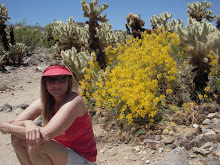Here's Part III of a 2008 interview with Curt Sauer, the superintendent of Joshua Tree National Park for the last seven years.

In Part I and Part II of this interview I talked with Curt about his background and his concerns regarding Joshua Tree National Park.
Allison: Curt, what do you take pride in at Joshua Tree National Park?
Curt: I'm proud of the overwhelming positive support for this park and its resources. In the five years that I've been here, I have yet to find someone who does not like the park. Folks may not like some of our use rules or the size of the campsites, et cetera, but no one dislikes the park and its programs. Old-timers still call it the Monument. That's an amazing statement for a superintendent to be able to make.
I'm proud of the people who work at this park. The employees care about this place. They strive to produce excellent results within the budget they are given. Many of them give extra hours to the park, its programs, and to the visiting public.
Allison: What else do you take pride in?
Curt: I'm proud of the accomplishments we've made to date concerning threats to the park from outside development. Eight thousand acres on the southwest boundary of the park,
known as Joshua Hills (mentioned in Part II of this interview) , were slated to become a city of 35,000 people. The land has been acquired by a host of partners and will be delegated as open space in perpetuity.
We are in the process of acquiring 639 acres east of Yucca Valley with private funds to prevent degradation of an area of Nolinas (a beautiful, flowering plant related to the agave) and to stop the potential development of this hillside. Because of this, Joshua Tree National Park is protected and the town of Yucca Valley will have a viewshed into the park sans development.
A basin-wide group called the Open Space Group is working to protect the treasures of the Morongo basin. Local towns, federal and state agencies, as well as local elected officials and water boards are all involved.
Thank you, Curt, for sharing your insights and concerns about Joshua Tree National Park! For anyone who hasn't visited the park, it's a wonderful place to spend a day, a weekend, or a week experiencing its beauty.





